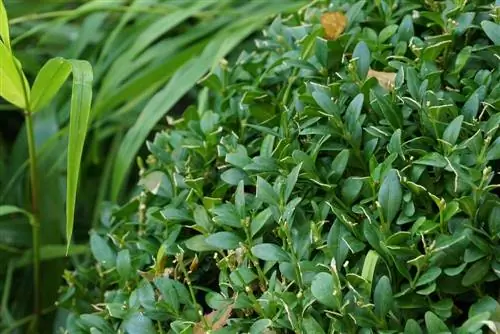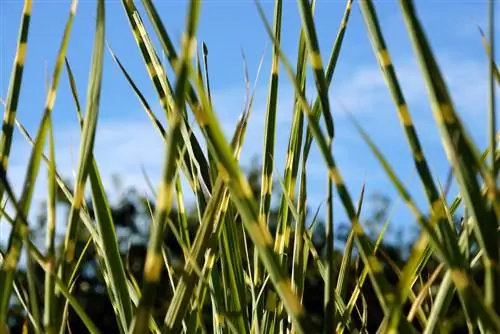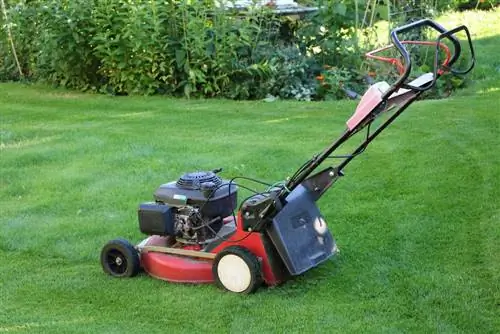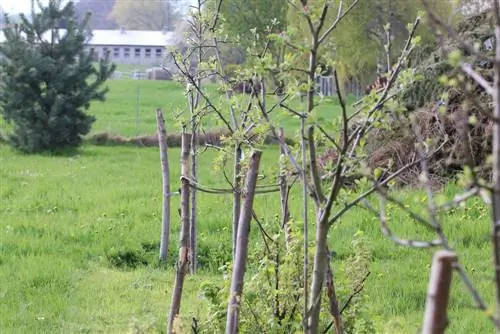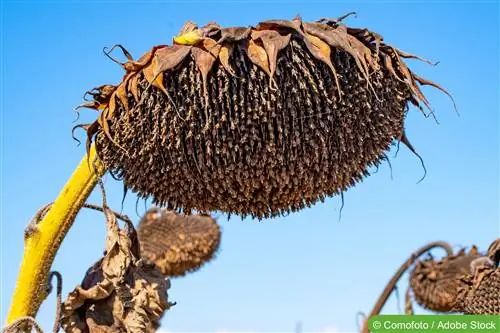- Author admin [email protected].
- Public 2023-12-17 03:39.
- Last modified 2025-01-24 12:45.
For the ideal pruning of a boxwood, different times must be observed. Depending on how the plant was cultivated, it also needs to be cut. A boxwood hedge can be planted in the garden as a privacy screen, the boxwood can be cultivated as a solitary shrub as a simple shrub or cut into a decorative shape. Since it is a very slow growing plant, it is important that it is pruned regularly at the appropriate times. Spring, March and April, and late summer, September, are particularly important.
Rough cut in spring
The boxwood can be cut throughout the frost-free period. The months of March and April in the spring should be mentioned here, when the rough cutting should take place. When it comes to rough cutting, care must be taken to ensure that it is always carried out before the new shoots appear. Because in this way it can maintain the shape it should have in summer. The days on which the boxwood is cut are also important, because a rainy day is not ideal here. Therefore, the plant should only be cut on an overcast but dry day. This prevents the tree from getting sunburnt from the water on the interfaces when it is later exposed to sunlight. Fungus can also penetrate more quickly if you cut on a wet day. The rough cut in spring is carried out as follows:
- use conventional hedge trimmers
- Special boxwood shears are also available in stores
- forgo electric hedge trimmers
- this causes damage to the plant, like blurred scissors
- If a fungus penetrates the frayed interfaces, damage can occur
- Branches and shoots, in the worst case the entire plant, die
- Do not cut the plant on a sunny day
- because there is also a risk of sunburn from the escaping plant sap
- This creates an unsightly brown color
- Cut hedges or individual boxwoods back as far as desired
- When making a rough cut, you can also cut into old wood
- this can be done if overall reductions are to be made
- cut the individual boxwood or hedge into the desired shape
- since the plant usually also forms leaves inside, there are no holes
Tip:
Since boxwood is highly poisonous, gloves should always be worn when working. If the buxin comes into contact with a wound, it can become seriously infected.
Fine cut over the summer

The so-called fine cut can be done from April to September. This can be done at any time during the summer months on overcast days or in the evenings. To do this, all shoots that have grown out too far are shortened to the desired length. This means that the hedge or the cut solitaire retains its shape throughout the summer. However, if possible, no more cutting should be carried out after September, as the weather conditions may then no longer be optimal. A fine cut can be done at any time during the summer months, but it makes sense to make a fine cut at least twice. Once at the end of April/beginning of May and the second time in August or September. Of course, long protruding shoots that spoil the appearance can be cut to the desired length at any time between the two necessary fine cuts.
Tip:
Always use sharp and disinfected tools for the cuts. Because dull blades tear or crush the leaves and shoots, fungi can easily penetrate these damaged areas. Bacteria can also penetrate the interface during a cut if the tool has not been disinfected beforehand.
Topiary cutting for a solitaire
If the boxwood stands as a solitaire, it can be given different shapes. This topiary is also carried out in spring. Balls on the various branches are particularly popular with hobby gardeners, but the plant can also be trimmed into any other shape. Pyramids or even animals can emerge. Because the tree is so versatile, it has played an important role in gardening for centuries. But such a cut is not that easy. Anyone who is artistically talented can give their boxwood an animal shape; everyone else should ideally start with a ball cut. But you also need a little dexterity with this topiary. You can proceed as follows:
- make a stencil for geometric shapes
- for a ball, cut a cardboard template in a semicircle
- place these in different places on the boxwood
- all protruding shoots are cut off
- usually cut from top to bottom
- Get a pre-made wire template from a well-stocked gardening store
- these are also available in animal or other intricate shapes
Tip:
If you only cut after September, there is always the risk that the newly formed shoots will no longer mature after such a cut and could freeze to death if winter sets in early.
Boxwood planted as a shrub
Even if the boxwood was simply planted as a shrub that should not be given a special shape, it must be cut regularly. Here too, a rough cut should be carried out in spring. All shoots from last year are cut back. This way the leaves can compact better. All dried branches, including those inside the bush, must be removed. This is how fungal diseases can be prevented. If a boxwood has been planted as a shrub and not pruned for years, then it should be given a rejuvenation treatment by cutting it back vigorously. The box can sprout again in the next few weeks over the summer. So that it grows strong. Here too, a fine cut should be made over the summer and long shoots should be shortened.
Tip:
A boxwood is easier to cut if it has been watered beforehand. Then the branches are juicier and easier to cut. Therefore, give the box a watering one to two hours before the planned cut. However, make sure that you only water from below at the roots; the plant itself should not come into contact with the water.
Pruning in case of fungal infestation
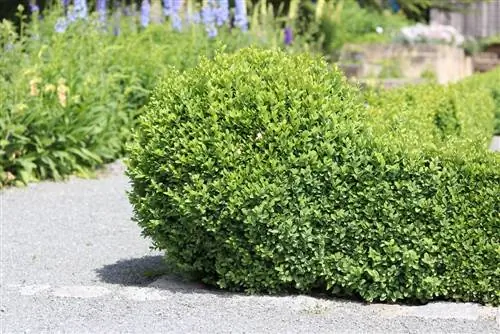
If the boxwood has been infected by a fungus, you must act quickly so that it cannot spread to the entire plant or to surrounding plants, for example in a hedge. If brown leaves are found that cannot be caused by sunburn, immediate action must be taken. When the first leaves fall off and the shoots die, the infestation is already very advanced. A vigorous pruning should then be carried out here, in which all affected parts of the plant are removed. It doesn't matter what time of year the fungus appeared; it needs to be cut, even in summer or late autumn. When making this cut, you should proceed as follows:
- do not shred the removed parts or put them in the compost
- these must be disposed of with household or residual waste
- also clean the soil around the plant
- After cutting, dispose of all fallen leaves and the top layer of soil
- Disinfect the cutting tool immediately after the process
Tip:
If a boxwood is already severely damaged, radical pruning will no longer help. The plant should be discarded altogether.
Conclusion
It's very easy to stick to the boxwood pruning calendar. Because the rough cutting takes place in spring. This is the most important cut of the year, because now the tree is cut back into the shape that it should retain over the summer. Before new shoots form, you can also cut into the old wood if necessary. We then continue with the fine cutting, which can take place in the months between April/Christmas and September. Only new shoots that have become too long are cut. Another cut could be necessary if the boxwood has been attacked by a fungus. In this case, there is no need to adhere to a time limit but rather you need to act quickly. Hobby gardeners who have cultivated their boxwood as a solitary plant in the garden also know topiary. If you stick to the different cutting phases, you will enjoy a very decorative tree or a dense hedge for a long time.

